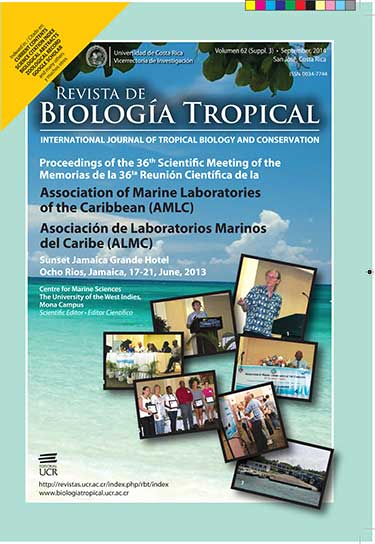Abstract
The queen conch Strombus gigas is an important fishery in the Caribbean, whose populations are currently overexploited. Since the decade of 1980 there have been several studies on aquaculture, resource management and area rehabilitation. However, little is known about its behavior in a natural environment and the influence of environmental parameters. Monthly surveys, from January to November 2012 were conducted in in Xel Ha, to observe and quantify six behaviors of S. gigas: rest, feeding, movement, burying, copulation and spawning. The observations were made every hour from 8h to 17h by free diving through three transects with three replicates each. Each behavior was observed 90 times each month. Salinity, temperature and dissolved oxygen were registered at the bottom. We found the highest number of snails at rest in July and the lowest in March and September. Feeding and movements had a peak in August. Most buried in October and November. Copulation was first observed on March with a peak in June and July to October’s spawning. In daytime observations restingt had a peak at 8h; feeding and moving at 12 to 17h. Copulation and spawning did not have a clear pattern. Variations between months and hours (resting, feeding, moving and buried) were significant (p<0.05). Resting correlated with temperature and being buried with oxygen level (r=-0.5803; p=0.0536). Feeding and moving correlated with temperature and salinity. These results should be useful for the conservation, restoration and aquaculture programs. Rev. Biol. Trop. 62 (Suppl. 3): 215-222. Epub 2014 September 01.
References
Aldana, D., & Brulé, T. (1994). Estado Actual de la pesquería, del cultivo y programa de investigación del caracol Strombus gigas en México. En Appeldoorn, R. S., & Rodríguez, Q. B. (eds). Queen Conch Biology, Fisheries and Mariculture. Caracas, Venezuela: Fundación Científica Los Roques.
Aldana, D. (2006). Overview del patrón reproductivo del caracol Strombus gigas para diferentes localidades del Caribe. 57th Gulf and Caribbean Fisheries Institutes, 771-790.
Aldana, D., Sánchez, M., Reynaga, P., Patiño, V., George, A., & Baqueiro, E. R. (2005). Crecimiento y temporada reproductiva del caracol rosado Strombus gigas en el Parque Xel-Há, México. 56th Gulf and Caribbean Fisheries Institutes, 742-754.
Brownell, W. N., & Stevely, J. M. (1981). The biology, fisheries, and management of the queen conch, Strombus gigas. Marine Fisheries Review, 43(07), 1-12.
CITES-Convention of International Trade in Endangered Species of Wild Fauna and Flora. (2003). Review of significant trade in specimens of Appendix II species. 19th Meeting of the Animals Committee, Geneva Switzerland.
Davis, M. (2005). Species Profile Queen conch Strombus gigas. SRAC Publication No. 7203.
Davis, M., Hesse C., & Hodgkins, G. (1987). Commercial hatchery produced queen conch, Strombus gigas, seed for the research and grow-out market. Proceedings of the Gulf and Caribbean Fisheries Institutes, 38, 326-335.
De Santis, C. (1982). Algunos aspectos de la ecología trófica del Botuto (Strombus gigas) con miras a su cultivo en el Archipiélago de los Roques, Venezuela. Tesis de Licenciatura. Universidad Central de Venezuela. Caracas, Venezuela.
FAO. (2007). Report on the Regional Workshop on the monitoring and management of Queen Conch, Strombus gigas. Kingston, Jamaica: FAO Fisheries Report No. 832.
Hesse, K. O. (1979) Movement and migration of the queen conch, Strombus gigas, in Turks and Caicos Islands. Bulletin of Marine Science, 29(3), 303-311.
Orr, K. S., & Berg, C. J. Jr. (1987). The Queen Conch. Miami, USA: Finney Company Incorporated.
Peel, J. R., Saenz, R., May, E., Montero, J., & Aldana-Aranda, D. (2010). Importance of a Marine Protected Area in the Mexican Caribbean on the Conservation of the Endangered Species of Queen Conch, Strombus gigas. GCFI Book of Abstracts, 63, 39.
Perez, M., & Aldana, D. (2003). Actividad reproductiva de Strombus gigas (Mesogasteropoda: Strombidae) en diferentes hábitats del Arrecife Alacranes, Yucatán. Revista de Biología Tropical Suplemento, 4, 119-126.
Randall, J. E. (1964). Contributions to the biology of the “queen conch” Strombus gigas. Bulletin of Marine Science of the Gulf and Caribbean, 14, 246-295.
Stoner, A. W., & Sandt, V. J. (1992). Population structure, seasonal movements and feeding of queen conch, Strombus gigas in deep-water habitats of the Bahamas. Bulletin of Marine Science, 51(3), 287-300.
Stoner, A. W., & Ray-Culp, M. (2000). Evidence for Allee effects in an over-harvested marine gastropod: density-dependent mating and egg production. Marine Ecology Progress Series, 202, 297-302.
Fig. 1. Variaciones mensuales del comportamiento de S. gigas: a) reposo, b) alimentación, c) movimiento, d) enterrados, e) cópula y f) Desove. *diferencia significativa, n=90.
Fig. 1. Monthly behavior of queen conch S. gigas: a) resting, b) feeding, c) moving, d) buried, e) copulating, f) spawning. *Significant difference, n=90.
##plugins.facebook.comentarios##

This work is licensed under a Creative Commons Attribution 4.0 International License.
Copyright (c) 2014 Revista de Biología Tropical






